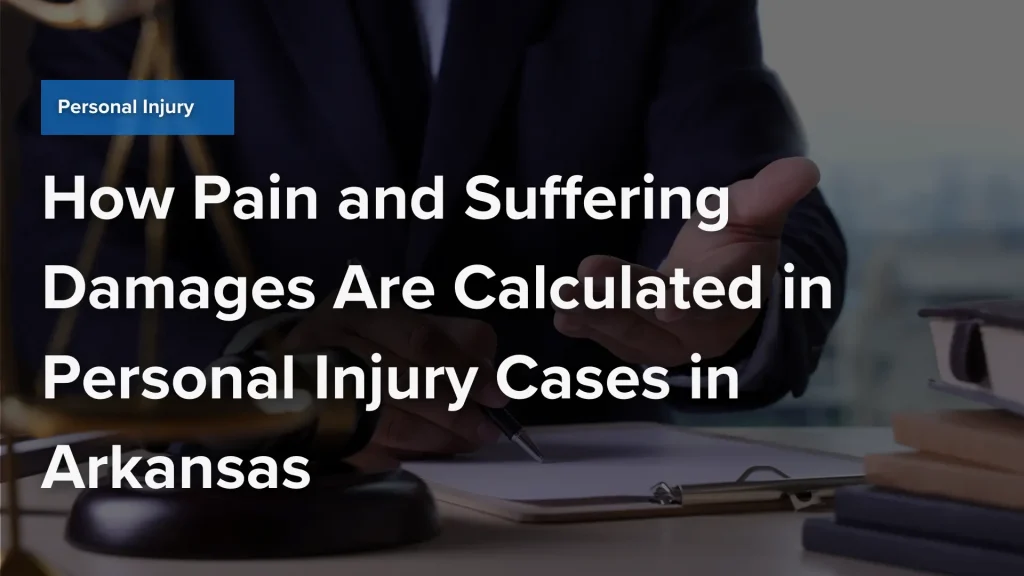Posted on Tuesday, July 1st, 2025 at 9:00 am

Personal injury cases aren’t just about physical injuries or medical bills. They often involve deep emotional trauma, lingering anxiety, and life-altering disruptions. Arkansas law allows injured individuals to seek compensation for economic and non-economic losses, including what’s commonly known as pain and suffering. But how do courts determine the value of those intangible losses? That’s where the basics of pain and suffering compensation come in.
Let’s break down what pain and suffering compensation covers, how it’s proven in court, and how Arkansas courts typically calculate these losses.
What Is Pain and Suffering Compensation?
Pain and suffering compensation covers an injury’s emotional, mental, and physical impact. It includes chronic pain, PTSD, and loss of enjoyment. Additionally, Arkansas courts recognize these lasting effects and let injured victims seek non-economic damages that reflect how the accident still affects their daily lives. However, proving negligence in personal injury is a crucial part of this process—you must show that someone else’s careless actions directly caused your injuries and the life-changing impact that followed.
Pain and suffering can look different depending on the person and the incident. Some examples include:
- A car crash survivor who now fears driving and has recurring panic attacks
- A parent who can no longer play with their kids due to a permanent injury
- A traumatic brain injury survivor who struggles with memory, mood swings, or sleep
In these cases, the loss isn’t just physical – it affects every corner of life.
How Pain and Suffering Compensation Is Calculated
Arkansas doesn’t follow a strict formula for calculating pain and suffering. Although courts and insurance adjusters consider several factors to assign a value to your losses:
- Severity and Type of Injury – The more serious or long-lasting the injury, the higher the potential pain and suffering compensation. For example, traumatic brain injuries or spinal cord injuries usually involve greater emotional distress and physical pain.
- Length of Recovery – The longer you’re in recovery, the more opportunity there is for anxiety, depression, or chronic discomfort to take root.
- Impact on Daily Life – If your injury affects how you work, socialize, or enjoy life, that raises the value of your claim. This includes being unable to walk your dog, attend social events, or engage in hobbies.
- Psychological Effects – Are you undergoing therapy? Have you been prescribed medication for trauma or depression? Emotional symptoms like irritability, mood swings, or fear matter in court.
- Jury Perception – If your case goes to trial, the jury plays a pivotal role. Their sense of fairness often influences how they interpret your non-economic losses.
Arkansas courts may use two methods to calculate pain and suffering. The multiplier method multiplies your economic losses by a number (usually 1.5 to 5) depending on the severity of the injury – for example, $10,000 in medical bills multiplied by 3 would equal $30,000 in total damages. The per diem method assigns a daily rate for your pain and multiplies it by the number of recovery days.
These methods aren’t guaranteed. Arkansas judges and juries have broad discretion, so having firm, organized evidence matters.
Please read more about workers’ compensation benefits here: Former NFL players seeking workers’ compensation benefits for CTE
How to Prove Pain and Suffering in Court

Unlike medical bills, there’s no receipt for emotional suffering. You need evidence showing how the accident affected your daily life and well-being to succeed in a personal injury claim.
Here’s how that’s done:
- Medical and Psychological Records – Documentation from doctors, therapists, and counselors is critical. If you’ve been diagnosed with anxiety or PTSD or are receiving treatment for chronic pain, this supports your claim.
- Daily Journals – Some plaintiffs keep journals describing their pain levels, emotional states, and limitations. These can reveal how an injury disrupts daily routines or personal relationships.
- Testimony from Friends and Family – Loved ones can offer insight into the psychological impact of the injury. Have you become withdrawn? Are you irritable or more dependent on others? Their observations help paint a complete picture.
- Expert Witnesses – Medical professionals, mental health experts, and vocational specialists can testify about the long-term effects of the injury on your quality of life, career, and relationships.
- Visual Evidence – Photos, videos, or personal statements presented during trial can help juries understand the real emotional toll of an injury.
You must show not only that you’ve suffered, but also how deeply it has affected your emotional and physical health. That’s where experienced legal guidance makes a difference.
Don’t Leave Non-Economic Losses Out of Your Claim
If you suffered an injury in Fort Smith, your case might involve more than doctor bills. At McCutchen Napurano - The Law Firm, our personal injury attorneys in Arkansas go after compensation for emotional distress, trauma, and long-term pain. We know injuries can change your day-to-day life in ways that don’t always appear on paper, and we’re here to help. Our team is here to help you understand your rights and take the first step toward securing the necessary benefits. Contact us online or call (479) 783-0036 today for a free initial consultation.




